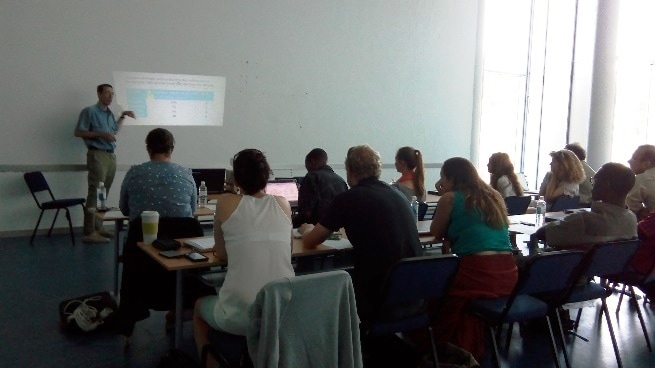|
CCB hosted a camera trap workshop in late March 2017 with guest presenter Dr Jim Sanderson from Global Wildlife Conservation (GWC). The workshop was an opportunity for researchers and others interested in camera trapping to learn and discuss general issues. Dr Sanderson spoke about basic camera trapping methods and new programs he has developed to improve photo handling and reducing errors, and Dr Peter Apps spoke about some trials he has been running to compare camera brands and placement of traps. The workshop was well attended by 15 people and was successful at capacity building within the research community.
2 Comments
ITB Berlin which took place the week of 8th – 12th March 2017 is the largest world tourism fair. The fair, which attracts thousands of spectators every year, played host to over 10 000 exhibitors from more than 180 countries showcasing their latest tourism products and services. Botswana, led by Botswana Tourism Board (BTO), has been a regular exhibitor at the fair since 1983 and they presented information on the country’s diverse tourism products and services with a great emphasis on sustainable tourism. To intensify the local offerings and creating the much needed awareness, BTO put up 50 life size rhino sculptures around the venue that were designed by local artists to represent the country’s tourism diversity. CCB benefited from a considerable sponsorship from Tlhokomela Trust whom sponsored a CCB rhino at the event to create awareness about who we are and what we do and Philip Jansseune for the artwork. We thank you all for the opportunity that was a great international awareness raising opportunity for us then and beyond. The event was reported to have been a huge success with satisfied traders and visitors. In August 2016, the CCB research team initiated a study in the wildlife management areas (WMAs) on the western boundary of the Central Kalahari Game Reserve (CKGR), looking at factors influencing carnivore occupation. The team used camera traps at 98 different sites across an area of 15000 km2, the largest camera trap survey conducted so far by CCB. Permission was granted by communities living in these areas and results of the study will be provided back to the community. As the area is bounded by protected areas, communal farming areas and commercial cattle farms, the goal of the study is to look at whether these land-use areas influence large carnivore occupancy in addition to distance to human settlements, available water and prey, and habitat. The study ended in December 2016 and camera trap processing is still underway, but so far the team has detected photos of all the six large carnivores (lion, leopard, cheetah, African wild dog, spotted hyena and brown hyena) as well as a number of smaller carnivore species and herbivores as well. This is great news for these partially protected areas in Botswana, as WMAs are often used as buffer zones to protected areas, both supporting wildlife and as areas for sustainable natural resource utilisation. Furthermore, they can be useful as a means to reduce conflict with nearby farming areas. Knowing that these particular WMAs show that wildlife is still present and perhaps thriving in these parts, as well as what influences their distribution, is vital for management and highlighting the value of these areas.
|
SearchArchives
May 2024
Categories |






 RSS Feed
RSS Feed
